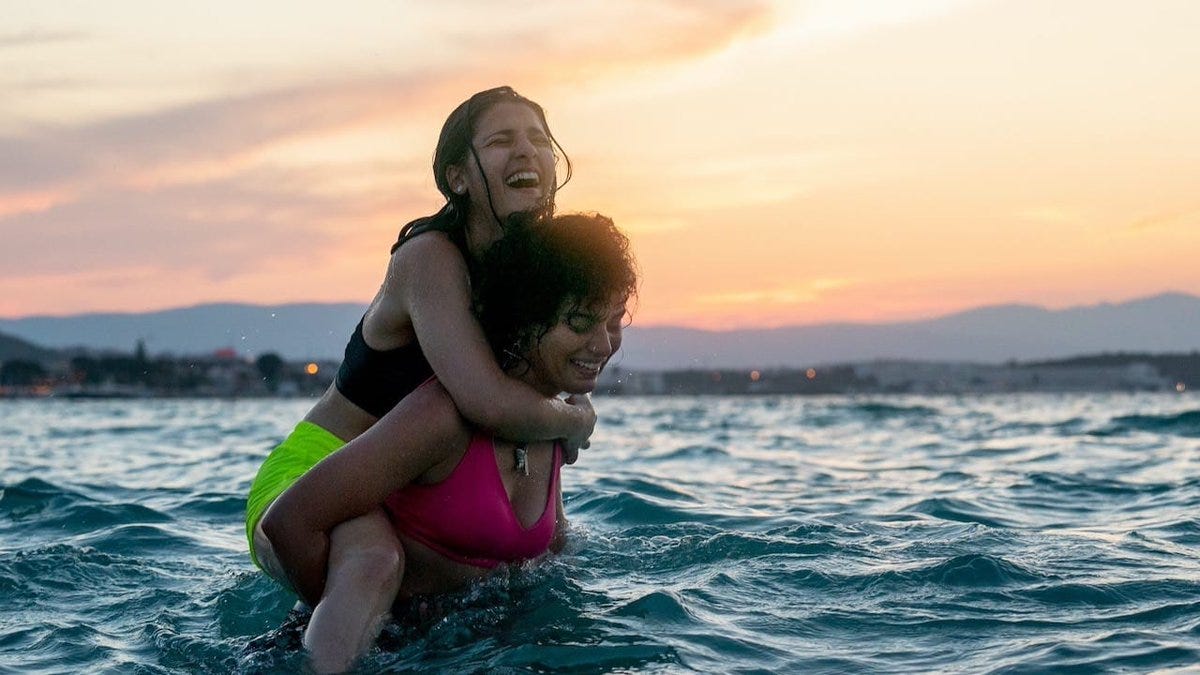Face down in the water, I see a wet wall of murky brown, opaque as lentil soup.
The sea warms my chest and thighs as I breaststroke past the jetty. But once I switch to freestyle, stroking below the surface, my arms chill. I breathe left and see red: the kayak Mom and Tom are paddling. I breathe right and see a blue blur of water and sky.
It’s Saturday afternoon and I’m practicing swimming in Long Island Sound, visiting friends in coastal Connecticut. Two weeks from today, I’ll swim across the Hudson River. Eek.
I’m comfortable swimming laps in pools. This summer, three weeks of Adult Swim camp has boosted both my stamina and confidence. And two months ago, I practiced a bit of open water swimming in the tranquil turquoise waters of Bermuda.
But today’s trial feels disorienting and disconcerting. I can’t see anything but brown in the water. I can’t tell if I’m swimming straight. And I can’t tell how fast I’m moving or how much distance I’ve covered, which means I can’t reliably pace myself.
To get my bearings, I try to follow my aunt’s advice from a few weeks ago: choose a target in the distance and every few strokes lift my head and look forward.
I aim for a white buoy. But in the split second I lift my gaze, my goggle lenses fog and I can’t see the target. After a few minutes, I pause and pick another spot to sight: a rocky island. The visibility is better, but barely. Finally, I pick a pier in the distance. No improvement.
Treading water, I assess the problem with Mom and Tom. Lifting my head to orient myself—like an ocean lifeguard or water polo player—is tiring and stressful. Essentially, it’s learning a new way of swimming. I can’t do that in only two weeks.
Instead, we decide I should cut my losses and swim to shore parallel with the kayak. That way, Tom can navigate while I focus my energy on swimming. We agree to do the same strategy in two weeks, when he’ll be my kayak escort across the Hudson River.
Swimming in open water next to a boat reminds me of three inspiring swim movies (The Swimmers, Nyad, and 100 Metros) and a memoir (Swimming to Antarctica) in which extraordinarily driven people risk their health, safety, and lives to swim seemingly superhuman distances.
I will never swim the Mediterranean like Yusra and Sarah Mardini or from Florida to Cuba like Diana Nyad. I cannot fathom how Ramón Arroyo finished an Ironman triathlon with multiple sclerosis or how Lynne Cox braved bitter cold and dodged deadly icebergs to swim the Bering Strait.
Still, their stories remind me of the power of practice, patience, and persistence, and how success is often—if not always—the result of learning from your failure.
Whenever someone cites Samuel Becket’s famous formula on failure, I roll my eyes.
Today, I suppress my cliché aversion and appreciate the depth of his mantra.
“Ever Tried? Ever Failed? No Matter. Try Again. Fail Again. Fail Better.”
Words to live by—in the water, in life.
Can I Kick It?
Monday morning brings a fresh lesson in failure.
I grab the pool wall, gasping. I’ve completed only half of today’s scheduled workout (10 x 200 yards with 20 seconds rest between sets) and finishing the second half feels daunting. While I’m slugging water and watching the seconds tick on the digital clock, Meg approaches and gives me the bad news: My kicking is all wrong.
When you swim freestyle, she says, you’re supposed to kick continuously, alternating feet, in a regular rhythm. She pantomimes the two-beat pulse with her hands.
Apparently I am kicking five beats, pausing every sixth kick, then repeating the cycle.
Basically, my kick has a hitch, which slows me down.
Also: I am not kicking hard enough.
“You haven’t made a single splash,” Meg says.
“You’re not supposed to kick beneath the surface? Like a duck?”
“Nope.” She chuckles. “Have you seen the Olympics? Do you see how much they splash?”
Also: I am not lifting my hips high enough, so my legs dangle too low in the water, which adds drag, which slows me down and makes me exhausted. Really? I thought I had corrected this mistake the last time.
“Still?”
“Yep,” she says. “Worse than ever.”
In the next set, I focus on my feet, trying to kick a steady rhythm, lift my heels above the water, and make a splash. When I get it right, my body zooms through the water. But incorporating the new technique is mentally and physically tiring. Invariably, I revert to old habits. Then I catch myself and try the new way again.
After practice, I tell Meg my legs felt unwieldy and sluggish when I tried to fix my kick.
“Because you’re trying to raise your hips higher,” she says. “But you’re not there yet.”
I appreciate how she reframed her feedback from negative (“Worse than ever”) to positive (“not there yet”), even if I know I needed to hear both messages.
Still, it feels like I’m learning to swim. Again.
As I’m toweling dry on the deck, Meg calls my name and points out her youth swim team now in the pool, twenty or so tweens speeding down the lanes with kickboards.
“See,” she says, smiling. “Look at that splash.”



